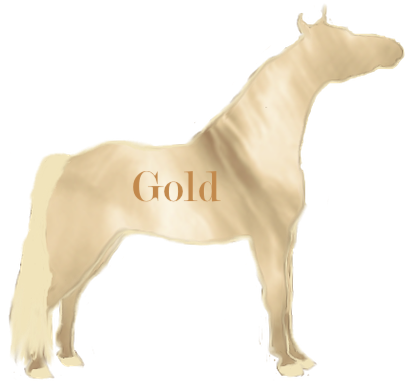
If a horse inherits the champagne gene from either or both parents, a coat that would otherwise be chestnut is instead gold champagne, with bay corresponding to amber champagne, seal brown to sable champagne, and black to classic champagne. A horse must have at least one champagne parent to inherit the gene, Champagne is not a recessive gene, If the horse has champagne lineage but does not express the dilute, the horse is NOT a carrier of the champagne gene The most distinctive traits of horses with the champagne gene are the hazel or amber eyes and pinkish, brown freckled skin. A champagne foal at birth has bright blue eyes and pink skin, eyes begin changing at approximately 3 months of age.
The color of the skin is the single most important visual identifier of champagne horses: in the adult horse, the skin is "pink with abundant dark freckles, except under white markings". This are freckles - not mottles, splotches, specks, or blotches - are dark and may have a purple cast, and are small and numerous. Most adult skin color does exhibit an overall lavender tone. The color qualities of the skin are most evident around the eyes and muzzle, under the tail, and on the udder or sheath.
The eyes of an adult champagne horse are most often described as hazel or amber. In the foal or very young, the eyes are bright blue to blue-green and the skin is bright pink. The champagne blue foal eye is creamier than other types of blue eye, such as the bright pigmented blue seen on some Splash White or Overo horses.This is a very detailed article written by Carolyn Shepard (ICHR): "Just About Everything You Need to Know About Champagne Colored Horses"

Is, as its name suggests, the coat color most associated with the champagne gene. It is produced by the action of champagne on a black coat. The body coat is chocolate, the mane and tail a darker shade. The legs may also be slightly darker.

Is produced by the action of champagne on a seal brown coat. It is visually difficult to distinguish from classic champagne. For Instance you cover your bay mare with an amber champagne stallion, your mare produces what you think to be classic. At this point a test will be needed as the mare could in fact be a seal brown and not bay at all. If the foal is Agouti this will give you a good idea the base color of mare to be seal brown and not bay as expected. Seal Brown as well as Sable will have a mealy brown color on muzzle and flank area.

Is produced by the action of champagne on a bay coat. The coat is orange golden with chocolate points. Just as there are varying shades of bay, the amber body coat may vary in shade as well. The legs are often lighter than the mane and tail, and the colored points may be difficult to see.

Is produced by the action of champagne on a chestnut coat. The coat is gold, and the mane and tail are typically creamy white. In some cases, the mane and tail may be self-colored, matching the body coat. These gold champagnes are sometimes called "dark gold" and may be an all-over apricot shade. Dark gold champagnes can be confused with red dun at birth.